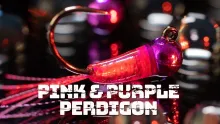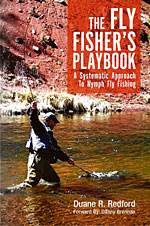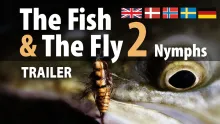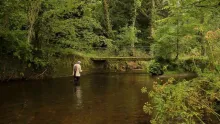This could be an article in a series called "Nymphing From Top-to-Bottom: The Untold Secrets". This article covers ways to get a fly to fish deep in the water by adding weight or using different lines and casting or mending techniques.
When you fish a nymph it is a good idea to go deep - really deep. A good rule is that if you do not loose a fly to the bottom from time to time, you are not deep enough. Here are a few reasons why that is important and a bunch of hints on how to get down there.
Notice about lead
When this article says lead, read it as 'something heavy'. Lead is prohibited on many fishing waters, and should generally be avoided and replaced by a substitute. Plenty are available on the market in many shapes. More further down...
Warm weather
When warm weather hits the fishing water - either during a normal fishing day or in the warmest part of the season - the trout seem to stop feeding and disappear. Of course it is not so. The fish just find their way down into the cooler waters of the stream and following the diminished surface activity just start feeding on stuff that is in the water rather than on the water.
Cold weather
Same thing when it is very cold. The metabolism of the fish will slow down to a minimum in the cold water and the activity and food intake will diminish into almost nothing. Staying close to the bottom will be interesting to the fish because the current is slower, the water is warmer and most food items will be there and not at the surface.
|
|
|
|
Dry - in more than one sense
No matter what, most fish stay close to the bottom and - according to my knowledge - most fish even feed primarily on subsurface food items such as nymphs and emergers as well as scuds and other aquatic animals.
Sure dry fly fishing is fun, and sure it is exciting to watch a fish rise to you fly. But watching your fly pass over seemingly empty water time after time with no strikes is not my idea of a good time. When that happens, I switch to a nymph. And preferably a heavy one.
Drifting downstream
When fishing a nymph for deep dwelling fish, you want to fish close to the bottom. Most fish will rest here for the reasons as already mentioned above:
- the current is weaker by the bottom, therefore it requires less energy to stay there
- on warm days the water is cooler near to the bottom
- on really cold days the water is warmer close to the bottom
- there will be food items drifting by
Insects living in water spend a much larger amount of their life in the water - preferably on the bottom - than on the surface. Most flies that hatch, actually sit on the water for literally seconds after having spent at least a year in the water - mostly on the bottom, but sometimes also in the water column. Other life forms spend all their life down deep.
Nymphs and other insects are torn loose from plants and gravel either by accident or purpose, and drift downstream in a more or less controlled manner. Most of them will sink or seek towards the bottom to find safety. Our nymphs should also be drifting downstream in a free floating manner, maybe seeking towards the bottom, maybe just tumbling and maybe sometimes rising towards the surface mimicking the beginning of an emerge and a hatch.
The abyss
The four basic ways of getting your fly to go deeper is:
- Weight in or on the fly
- Weight attached to the leader
- Sinking line or leader
- Line control - casting and mending techniques
Important addendum! Skinny flies sink faster.
There is actually a fifth way of getting a fly to sink faster and deeper: making it thin. The thinner and the less fuzzy the fly is, the faster it can penetrate the water. A fluffy, heavy fly will sink slower than a lighter, but tighter fly.
Thanks to Paul Slaney for pointing out this very important fact to me.
Examples that illustrate this fact are buzzers (often tied so skinny that they look like bare hooks with a lump under the hook eye) and some variations of the Czech and Polish nymphs.
The different ways have different final results, which we can quickly describe as:
- Weight on the fly: Fly is less mobile and acts much like a rock sinking, only hindered by the leader and line
- Weight on the leader: Fly is mobile and free to move - also higher than the sinker, which itself sinks like a rock as above
- Sinking line or leader: Fly is mobile, while line or leader works its way towards the bottom
- Line control: Fly drifts very freely and even a fairly light fly is allowed to sink if line and current does not drag it to the surface.
These different methods can of course be combined to obtain whatever it might give of advantages.
Weight!
In other words: If we want to get down there is basically one sure way of getting there: weight! The more weight, the faster and further down the fly goes. The first natural place to add it is in the fly itself.
Think of the gold beaded nymph that was revived a couple of decades ago. A heavy brass bead added weight to an otherwise very standard and very anonymous nymph. The beadhead nymph is vastly successful and had been for decades - if not centuries - in parts of Europe, and has become equally popular in the US.
Think of a fly like the Dog Nobbler, the odd British stillwater pattern that can bring up fish from the bottom of almost any trout lake. Not to mention the good old Woolly Bugger...
Think of the Czech nymphs that we started seeing some 15-20 years ago. These extremely dense, very heavy and very simple nymphs that showed many anglers a whole new world: fishing very deep within a short distance.
Think of recent flies such as the Copper John. Small, intricate, complex pattern with epoxy and copper wire.
What is the common trait of all these successful flies?
Weight! Simple as that. All their other qualities not forgotten, they are plain heavy.
Ways with weight
There are many ways to add weight to a fly, and I will probably forget some in this list.
- use of heavy hooks
- use of heavy or at least non-floating materials
- covering with or incorporating epoxy or other sinking resins
- lead or similar material under the materials, wire, foil or other shapes
- heavy eyes
- bead head or cone
- metal tube
- split shot pinched on the hook
- lead or similar material cast onto the hook
I will later add an article with a few patterns, which in a simple manner illustrates some of these different ways of adding weight.
Secure
Most patterns can have weight added - even dries! Hans Weilenmann's CDC&Elk tied as a gold head emerger is an example. The bead transforms the dry fly into a nymph, that can be fished with a lifting motion to impersonate an emerging insect.
Many other patterns can easily be converted with beads or cones. Bas Verschoor's Cone Head Series illustrate this perfectly.
If you do not want the fly to look different, a few wraps of heavy thread under the body can do the trick.
No matter which method you choose, make sure that the weight is firmly secured to the hook. The heavy addition is bound to try to work itself loose in the cast, and will easily ruin an otherwise nice looking fly if it starts scooting up and down the hook shank.
Under the bead
Varnish or super glue is the easiest way to make weight stick. But in the case of beads and cones, it might be advisable to add a layer of thread under the weight in order to make it fit snugly. Most beads and cones have a large bore, which facilitates their passing over the barb and around the hook bend. Once in place behind the eye of the hook, they will typically wiggle quite a bit. Move the bead back on the hook shank and add a few layers of a thick tying thread just where the bead will sit. Varnish or glue and press the bead onto this seat. Now it cannot wiggle and will not come loose without severe violence.
Lead and other heavy wire should also be secured by wrapping tightly criss-cross over it and varnishing or gluing before the rest of the fly is tied. It is advisable to prepare a bunch of weighted hooks before commencing the tying of the actual flies. The glue or varnish will be dry, and you can avoid material sticking to the soft surface.
Alternatives to lead
I use the term lead throughout this article, but as already mentioned it should actually be read as "something heavy".
Lead is known to be a severe environmental poison, and apart from that prohibited on many waters.
Using substitutes can be both necessary and desirable.
Most substitutes made for the purpose are produced from tungsten. This material is considerably heavier than lead, but unfortunately also considerably more expensive. Other metals can be and is used, such as copper known from wire and tubes, and brass known from beads. Cast metal of different kinds is used for dumbbell eyes, which are also sometimes manufactured from brass. Of these only tungsten is heavier than lead, and it is definitely the best substitute where lead is usually applied.
The severity of lead pollution is clearly indicated by its place in this list from Agency for Toxic Substances and Disease Registry. It is number two on the list, well ahead of DDT, cyanide and other toxins and only surpassed by arsenic.
So consider lead a serious environmental hazard and use alternatives whenever possible.
Fishing the weighted fly
Most of us who have cast a heavy fly will know that it is not pure joy. The heavier the fly, the stranger the feel of the cast and the more need for a well adapted technique.
Slow and short is the way.
The fairly light and stiff modern rods used for trout fishing are not built to cast these heavy flies, and care must be taken not to overload them. They probably won't break, but their performance will be poor and casting will be tiring.
Do not try to push speed and distance when casting a heavy fly on a light rod, but deliver the fly with a lingering stroke and an open arc in order not to drive the rod too far. Keep false casting and double hauling to a minimum, and remember that you are fishing deep, so you can often go closer to your target. Unless the water is gin clear, the fish will not see you - and even in clear water, fish dwelling in shallow have a very small field of view.
The Czech and Polish style is the most extreme version of this casting style. In its most condensed form it just consists of lifting the fly out of the water slightly downstream and lopping it upstream without any false casts, without shooting off line, with no hauls or any other added extras.
Fellow angler Claus Bech Petersen picked up another method in New Zealand, where the Kiwis demonstrated a somewhat more extreme version of this cast referred to as the Tongariro haul, where heavy nymphs are pulled out of the water a fair bit downstream, using the friction of the line in the current to load the rod, which then catapults the nymph upstream for a new drift.
Under all circumstances: casting a very heavy fly calls for considerations.
The rig from hell
When I refer to the rig from hell, it's the very common combination of three things on the leader: a strike indicater, a lead shot and a fly - or a large dry fly, a heavy nymph and a smaller nymph AKA Hopper, Copper, Dropper. As most people who have tried casting such a setup will know it is a pain to handle and cast.
As efficient as it might be in the water, it is a menace to keep under control when in the air. It has a tendency to got its own ways: large and light components in one direction, heavy ones in the other - preferably turning around themselves and tangling up miserably.
As above the solution is to be calm. Large open loops, slow, short casts and keeping the rig as much on and under the water as possible is a very good solution to all potential problems. And it keeps the flies where the fish are: in the water.
And remember to inspect the leader regularly to ensure that you have no tangles. Just one cast with the sections of the leader crossed will lead to knots of Gordian dimensions. Make sure that you bring extra leader and tippet material anyway under all circumstances, because accidents are bound to happen.
Mend that line
When fishing in running water the mend is a really good method to get a fly to drift freely. Mending the line is simply moving the belly of the line upstream, thus preventing the current from dragging it downstream faster than the tip and the fly. A line belly moving downstream will pull the tip and leader, making the fly move in a different direction of faster downstream than the surrounding water. In dry fly fishing this is known as drag. Drag can also take place when fishing a nymph, except that there are no stripes in the surface to reveal it. But the fish will notice, and avoid eating stuff that moves unnaturally. Mending upstream can resolve this.
Simply lift the line off the water, leaving the fly where it is, and move your rod tip upstream as soon as you see the belly of the line "overtaking" the tip.
The slack introduced this way will aide the heavy fly in sinking, and bring it closer to the bottom. The fly may shift shortly due to the pull in the line, but when the line lands on the surface and starts getting pushed downstream again, slack will be introduced and the fly will move freely.
The mend can be repeated several times during a drift, dramatically prolonging the efficient fishing time for the fly.
Down-and-across
The method can be used on a down-and-across wet fly fishing style too. After you have cast across the stream, the line will be pulled towards your bank belly first, and the leader and fly will follow. This motion will pull the fly towards the surface. By mending away from yourself, upstream and towards the opposite bank you will introduce a bit of slack in the line, shortly allowing the fly to sink. It will still move downstream, but be able to go closer to the bottom. This method is particularly good to use right in front of a fish. The mend will often lift the fly a bit, then it will stop for a short moment, start moving again in its present lane while it sinks a bit due to the slack line. One of these movements can often entice the fish to a strike.
Split shot
Sometimes you want to fish a fly that is small or light, but still want it to penetrate the water and go deep. That means adding the weight somewhere else than on the fly. In our case that means on the line or leader.
To cover the latter first, the most common way of adding weight to the leader is by pinching a split shot or some other weight onto the line.
Split shot are easy to work with and can be added and removed from the line with some care and a set of pliers without leaving marks. But if you regularly need to add and remove weight - or just want to avoid using tools for the job - you might consider sink putty. This is a soft, sticky, heavy substance that you fold around the leader and press to attach. It is not quite as heavy as the metal split shot, but easier to work with and a good alternative if your split shots are lead.
The distance from the fly to the split shot or putty depends on the depth, weight of the added mass and the way you want to fish. Up to 50 centimeters or about 1.5 foot will usually do fine. Less is no problem.
As an alternative to the passive split shot, I warmly recommend using a heavy fly in stead of pure weight. This has some advantages: first of all no lead and secondly the "split shot" fishes! There is no rule saying that the weight must be in the terminal end of the rig. It might as well be the top fly that is the heaviest of a team.
In a similar way you can use a large dry fly as a strike indicator if you want to increase chances of hookup here. Steve Schweitzer's brilliant indicator might be very visible, but is does not catch fish - which reminds me that I actually saw a description of a brightly colored strike indicator tied on a hook in an British magazine recently.
A line that sinks
Another way of getting your fly to fish deeper is using a line that sinks. This is endorsed by many fishers who think that the fly should be unweighted and able to move freely, while the line should be the medium of moving the fly to its location - either in a cast or after, when the fly has hit the water.
The line can be an all sinking line or just a sink tip as well as it can vary in density and thus have different sinking rates.
An intermediate line will bring your fly under the surface and slowly towards the bottom while a line with a fast sinking tip can have almost the same effect as shot on the leader.
Some specially designed nymphing lines have sinking tips and/or brightly colored bands on the floating part to aide visibility and strike detection.
- Log in to post comments














Psst! Anyone want to
Psst! Anyone want to buy some depleted uranium? It's REALLY hot. Nuke those trout good. ;-)
In New Zealand coars
In New Zealand coarse anglers have shown a new way of getting the fly down to often phenominal depths and at great range by using long rods, up to 18 ft., (minimum 13 ft) mono lines, a tradiditional stick float with drifts of 30 plus meters drag free. Long rods make drifting a nymph between heavy weed beds far easier too with the better control that they offer on rivers that trditional fly fishers have given up on. Shot the float so just enough tip shows to see at distance with all the shot round the float bottom and fish a heavy weighted nymph up to 3 meters below. This technique works just as well on shallower water too; just set the depth by moving the float up or down to the required depth.
Search articles on "Long trotting" to get mor info'.
as most adept flyfis
as most adept flyfisherman are aware trout eat 80-90% of their food on the bottom or just above, I have been using the nymph teqnique for about 12 years now and it is the most productive way to catch trout I know.
it was very informat
it was very informative but i had a problem deciding if it was fresh or sea water